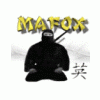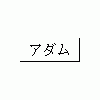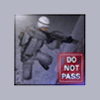Jak mnie takie artukuły wk....ale nie ważne tu kilka informacji na pozważnie:http://shell.world-net.co.nz/~jimgould/index.html
wiadomości:
Essence of Taijutsu
An essay by Hatsumi-sensei.
(translated by Stephen K. and Rumiko Hayes)
Taijutusu, literally translated as “skill with the body,” forms the basis for all understanding in the fighting arts of the ninja. By concentrating on developing natural responsive actions with the body during initial ninja training, one can then use the physical lessons as models for psychological and tactical training in advanced studies. The ninja’s taijutsu is made up of methods for striking and grappling in unarmed fighting, tumbling and breaking falls, leaping and climbing, conditioning the body and maintaining health, as well as special ways of walking and running.
Some of the more popular Oriental martial arts and training systems attempt to mold the practitioner’s ways of reacting and moving to fit a styliized set of predetermined movements. In effect, they are “adding to” the student’s total personality. The taijutsu of Togakure ryu ninjutsu works in the opposite manner to naturalize all movements by stripping away the awkward or unnatural tendencies that may have been picked up unknowingly over the years.
As a fighting system, taijutsu relies on natural body strength and resiliency, speed of response and movement, and an understanding of the principles of nature for successful results in self-protection. The techniques take advantage of natural employment of body dynamics. The students need not imitate some sort of animal, nor distort or deform the natural body structure, in order to emply the taijutsu techniques for self-defense.
The principles of taijutsu also provide the foundation for combat with weapons in ninjutsu. The loose, adaptive body postures and movements readily fit the fighting tools employed in the ninja’s art. Footwork, body balance, speed, energy application and strategy are identical for practitioners of ninjutsu, whehter fighing with fists, blades or chains.
The effectiveness of taijutsu as a total fighting system is based on the ninja’s reliance on the harmony inherent in nature. Even the fundamental fighting postures and techniques model themselves after the manifestations of the elements in our environment; and the advanced training methods use the balances of the psychological as well as the physical ways.
The five physical elemental manifestations of the physical universe are the classifications of solid, liquid, combustious, gaseous and sub-atomic potential, which are the chi (earth), sui(water), ka(fire), fu (wind) and ku (emptiness) of Oriental metaphysics. By increasing our observation and awareness of the interrelationships of these various levels of reality, we can develop the ability to see vast patterns of cause and effect that are unrecognized by other people around us. In this sense the practitioner of ninjutsu learns to use the natural progression of the universal cycles, and his body and intentions always adapt to the advances of any attacker. By coming into attunement with the scheme of totality, the ninja always knows the appropriate response for any given situation that confronts him.
Ninjutsu Hiketsu Bun
An essay by Takamatsu-sensei
The essence of all Martial Arts and military strategies is self protection and the prevention of danger. Ninjutsu epitomizes the fullest concept of self-protection through martial training in that the ninja art deals with the protection of not only the physical body, but the mind and spirit as well. The way of the ninja is the way of enduring, surviving, and prevailing over all that would destroy one. More than merely delivering strikes and slashes, and deeper in significanse than the simple out-witting of an enemy; ninjutsu is the way off attaining that which we need while making the world a better place.
The skill of the ninja is the art of winning. In the beginning study of any combative art, proper motivation is crucial. Without the proper frame of mind, continous exposure to fighting techniques can lead to ruin instead of self-development. But this fact is not different from any other beneficial practice in life carried to extremes.
Medical science is dedicated to the betterment of health and the relief of suffering, and yet the misuse of drugs and the exultation of the physician’s skills can lead people to a state where an individual’s health is no longer within his or her personal control. A nutritious well-balanced diet works to keep a person alive, vital, and healthy, but grossly over-eating, over-drinking, or taking in too many chemicals is a sure way to poison the body.
Governments are established to oversee the harmonious inter-working of all parts of society, but when the rulers become greedy, hungry for power, or lacking in wisdom, the country is subjected to needless wars, disorder or civil and economic chaos.
A religion, when based on faith developed through experience, a broad and questing mind, and unflagging pursuit of universal understanding, is of inspiration and comfort to people. Once a religion loses its original focus, however, it becomes a deadly thing with which to deceive, control and tax the people through the manipulation of their beliefs and fears.
It is the same with the martial arts. The skills of self-protection, which should provide a feeling of inner peace and security for the martial artist, so often develop without a balance in the personality and lead the lesser martial artist into warped realms of unceasing conflict and competition which eventually consume him.
If an expert in the fighting arts sincerely pursues the essence of ninjutsu, devoid of the influence of the ego’s desires, the student will progressively come to realize the ultimate secret for becoming invincible – the attainment of the “mind and eyes of god.” The combatant who would win must be in harmony with the scheme of totality, and must be guided by an intuitive knowledge of the playing out of fate.
In tune with the providence of heaven and the impartial justice of nature, and following a clear and pure heart full of trust in the inevitable, the ninja captures the insight that will guide him successfully into battle when he must conquer and conceal himself protectively from hostility when he must acquiesce.
The vast universe, beautiful in its coldly impersonal totality, contains all that we call good or bad, all the answers for all the paradoxes we see around us. By opening his eyes and his mind, the Ninja can responsively follow the subtle seasons and reasons of heaven, changing just as change is necessary, adapting always, so that in the end there is no such thing as a surprise for the ninja.
--------------------------------------------------------------------------------
Ancient Weapons of Warfare in China and Japan
by Mimi Yano
Today's weapons are the result of a long line of survival and military implements developed and passed down to us from our ancestors. Many of the traditional tools used in contemporary forms of martial arts bear similarities to their original templates created by earlier civilizations. Below is a brief descriptive comparison of a number of ancient weapons of warfare from China and Japan.
First is an introduction to the general history and context of the creation and use of the weapons. The sections that follow are: Sticks & Stones, Bows & Arrows, Blades, Guns & Canons, Armor and Other Weapons.
Introduction
The focus here is on weapons used specifically in warfare (as opposed to in ceremony or for other ornamentation) in ancient China and Japan. Weapons can be defined to include not only external/abstract physical materials but the human body, mental/psychological manipulation, the use of superstition, spiritual power, battle tactics, political maneuvering, espionage and more; however, the focus here is on the use of physical arms only. Also, I have refrained from an explanation of sociocultural/historical details surrounding each weapon.
Briefly speaking, there is little physical evidence to indicate the migination of primitive fighting in China. Earliest archaeological findings date back to the Shang Dynasty (1558-1050 B.C.E.), with preservations of military figurines, bronze weapons and armor. As arms evolved, new materials and styles were introduced. Where there was chronic warfare, greater variations occurred.
Japan's records of war date back to the beginnings of the Yamato period (3rd century C.E.) The great tombs constructed at that time also housed representations of the Japanese military and their armaments. Statues give a picture of a fighter's attire, which included bronze and iron accessories. During feudal eras, samurai, ninja and other less skilled peasant rebels emerged. All developed and refined their own techniques and fighting equipment.
Both countries included various types of armies and individuals ranging from professionally trained martial artists working for the rulers of the state, to oppressed warrior monks desiring to protect their rights, to family clans fighting for their own lives.
Stories passed down through oral tradition, ritual, stunning visual depictions of battle, demonstrate a rich history of passion, violence and valor. The characters of these tales also leave us a legacy of weaponry - some at the sacrifice of their lives.
Sticks & Stones
The first fighting tools of China and Japan can only be speculated as being what was most technologically simple - the action of hurling and striking with sticks and stones. As human culture developed, so did advancements in weaponry. Myths and legends reveal some records of martial tools. The more structurally simple weapons are described in this section.
Chinese weapons included the cudgel (a short stick) that could be used for striking and hurling. This later developed into a club - a thick, weighted stick with an enlarged rounded end. This evolved further still into greater clubs with larger heads. A stone (later metal) bound to a club made a adze, aided in the creation of the mace. Other innovations included the battle axe. Stone spearheads were also attached to long sticks for throwing; heavier spears were used for thrusting.
Japan's early simple weapons made use of sticks, staffs and canes. These ranged from approximately 3-7 feet long. Later variations included those that were hollowed out to conceal other tools (such as chains, spears, blinding powder) or built to create illusions in the weapon's appearance (in length, size, shape etc). Additions were made so that sticks became spears, halberds and more.
Bows & Arrows
Another early weapon (used also in hunting and sport) was the bow and arrow. Chinese forms were made of stone, wood, iron, brass and other materials. Structures ranged from simple bows that shot one arrow, to evolved complex crossbows that could throw up to ten arrows simultaneously. Each style had its own advantages: speed, accuracy, durability, depth, weight or use in different climates, seasons, strategies etc. Bow strings were made from hemp or rattan. Cases and stands prolonged the bow's life. Accessories included protective leather arm bands, rings for the fingers and thumb pieces customarily made from ivory. Bows were used for close to long range offense. Some shot distances of over 600 feet. Larger, complex bows needed more than one person to function it, smaller ones could be pulled by one person using hand or foot.
Chinese arrows were often made from bamboo, feathers (such as hawk or vulture) and metal, bone or stone points. Points could be up to 3-pronged and varied in length. Some created specific sounds (for example to signal). Fiery darts were used after 1000 C.E. Arrows were carried in arrow buckets usually made from deer hide.
Japanese archery was also important in war. Equestrian archery was in fact, a refined art. Bow and arrow were also used on foot. Early handheld long bows were made from bamboo or other woods assembled by glue. These ranged from 7-8 feet long. Short bows were less cumbersome and easily concealed. Arrows were often strategically used to first deter, distract and weaken opposing forces. Then lethal close range fighting would ensue. Bows and arrows could be carried and protected in bamboo tubes. Various arrowheads served different purposes (noise-making or cutting through thin armour). Arrows could also carry explosives, poisonous tips and flares.
Blades
Blades (of stone, later metal) were used and/or fixed to handles to create a greater diversity of weapons, improving fighting efficiency.
Chinese battle axes evolved with the utilization of iron blades, some variegated to forms of hatchets, others were combined with spear structures resulting in halberds (a stick with a long curved blade at one end). Other long weapons included lances, rapiers (for piercing/thrusting), sabres (for cutting) and refined spears with diverse types of points. Spears with detachable heads were created so that upon wounding the enemy, the point would remain inside the body. This prevented the opponent from rebounding with the attackers weapon, as now it also had no blade. Some points were barbed for the same purpose, to hook inside the enemies flesh. Varieties of pronged and crescent shaped blades were introduced. Lances ranged from 18-24 feet long, ending in hooks, tridents, gilded edges or 3-4 edged blades.
Shorter weapons included daggers. The sword was a longer form of dagger, with lengths between 4-10 feet. Handles could be up to twice the length of the blade. The single or double-edged blades were made from gold, jade, silver, iron, oyster shells or brass.
Blades also have a fantastic history in Japan. Prolonged halberd blades were attached to 6-10 foot staves. These functioned as long range swords to attack and forcefully drag mounted fighters off their horses; they were also used to attack horses themselves or slash, maim and kill ground opponents. The halberd was later replaced by a staff with a straight sword blade at one end. Blades varied in weight and served different purposes (for example, heavier blades could cut through armour). Sickle blades were also attached to accessories such as chains; these were used to neutralize and block sword blows. Blades with hooks aided climbing, striking or cutting.
Sometimes spears substituted arrows, but were often used on its own by foot soldiers. Spears functioned as a long range stabbing weapon; hooks, prongs or grapnels helped disarm the enemy and aided in climbing or other strategies.
Throwing blades are characteristic of the ninja. Varieties generally fit into the palm of one's hand and included flat plates with 3-8 points and straight blades with one or both ends sharpened. The practice of directing these through the air to targets was to temporarily distract enemies rather then attempt lethal injury. This art greatly impacted the exercise of hand-throwing knives and other bladed tools. Aside from being projected, these small blades could be also used for close range slicing. These weapons were easily concealed and took up little space and energy to carry.
The sword is well known in Japanese warfare as it symbolized the tradition of the samurai (other fighters used swords as well). Blades varied in size, shape, weight and decoration. The making of the 'samurai sword' was a refined and religious craft. The result was a beautiful and deadly killing tool for close range combat. It was often used for slicing. Short swords were more often used by peasants, as they did not have the same access to great sword artisans as the elite. Shorter blades allowed one to fight and move easily in confined spaces. They were also a utilitarian tool for breaking and entering into enemy buildings (for example used to pry open a door). Although the blade was the primary threat of any sword, the handle could also be used to jab and deliver deadly blows to opponents. Sword guards prevented blades from sliding onto the swordsperson's hands. Scabbards held and protected the swords; it also kept the carrier from cutting themselves. Other additions to swords included those that hid other weapons in hollows (such as in the handle). These unseen weapons included blinding chemicals, smaller blades, chains, explosives and more. Sword training often required the use of bamboo and heavier swords made from wood.
Guns & Canons
China's first 'guns' were large long reeds used to blow poison darts. Explosive powders were originally used for dramatic effects to scare enemies. Later these powders were adapted for use in iron barrels to propel shots, and so guns developed. Forms of match locks became wheel locks and later flint locks. This last type used a trigger and spring mechanism to ignite the powder. Crockery guns were also used; however, it was not as loud and violent as the iron gun which could significantly damage armour. Guns could shoot stones (later metal bullets) up to 300 feet. Bundles of flammable materials such as straw, reeds or thin sticks were soaked in fat or oil and helped ignite projectile weapons. Gun powder from foreigners arrived in 500-600 C.E. and was quickly adopted. Rifles became more common. China copied the Japanese blunderbuss (a type of old-style gun). When other weapons were no longer found threatening it was used to shoot heavy lead-weighted iron bullets.
Canons on wheels were used for land battle. Other canons were common in naval warfare (such as the submarine canon). By the 17th century weapons of fire also included larger explosives such as grenades or flasks and objects similar to rockets.
Japan also used blow tubes and poison darts as a basic form of gun. It could be used in silence to kill, or to deliberately cause attention, alarm or warning. Close range blow guns were used within a distance of 20 feet. Ninjas concealed the weapon through the use of disguise, making it seem like a common instrument (such as an umbrella or flute). Long range guns could also function on hydraulics. A poison, eye-irritant or flammable liquid could be shot.
The introduction of firearms came from European traders. The original guns functioned by lighting and dropping a match into the hole that would ignite propulsion. This was the harquebus. It was a light weight, match lock musket. It was quickly adopted because it required less strength and technique than bows and arrows. Later, similar versions of the musket were used. Guns (also bows and arrows) were used to defend fortresses and were made to function on battle ships. As stated earlier, the Japanese were first to use the blunderbuss before the Chinese. This old-fashioned gun was used for close-range, scattered shooting.
Depictions of the use of canons were detailed in various artworks. Canons helped to defend castles and were part of ground artillery. Mobile wooden mortar canons and hand held canons are examples of such battle inventory.
Other explosives, flares and flames were used to create distraction, to signal, to blind or injure an opponent or set fire on enemy territory. Poisoned smoke subdued attackers.
Armour
Armour served to protect a warrior from injury and as such was considered a primary weapon. It too underwent great changes through time.
The earliest Chinese armour were coats or scaled clothings made from several layers of rhinoceros hide. When these grew scarce, buffalo hide or shark skin was the substitution. Various regions also used whale-skin. Helmets, though somewhat exceptional in early times, were made from bronze.
Later armours were made from layered thicknesses of paper, to the use of copper, deer skin, iron, fish bones, turtle shells, silk lined cloths and more. Lacquers and varnishes were also used. A cloth bag carried the outfit.
Lamellar style armour (small metal plates attached together with leather thongs) became common. Mails (a metal fabric of many linked chains) were copied from foreign sources. Brigandines of iron, copper or leather were made as jackets, vests, underskirts or high boots. Even horses wore armours.
Shields were lacquered and painted, depicting symbols of army identification. Shields were first small and functioned as parrying sticks. Later they broadened in size and shape, able to ward off attacks from darts, arrows and blades. Shields were also used as an offensive weapon. Shorter narrower types were carried on chariots, other kinds by foot soldiers. Many were made from rhinoceros hide, wood, bound grass or bamboo. Chinese armours were often magnificently decorated.
Japanese armours were complex and also involved great detail. Peasantry did not dress elaborately in protective gear; however, the samurai was housed in armour. Complete suits starting from the loincloth to the body armour contained at least 23 items. These were a colorful assembly of lacings, metals, leathers, various fabrics and ribbons.
Helmets were sometimes horned or antlered to appear more terrorizing. Others were simple steel caps. Masks, gauntlets, thigh and leg guards contributed to the costume as did later solid steel breast plates. Various changes occurred during feudal ages but a same basic style was maintained for over 700 years. The weaknesses of armour were the openings to which arrows, spears and swords could penetrate. The neck was particularly vulnerable. Japan borrowed the lamellar style from China in the 15th century. Since then, armour became more elaborate.
Other Weapons
Beyond the above categories both China and Japan still had a vast array of weaponry used in warfare. In some battles, Chinese fighters used a recipe of birds eggs (often goose or duck) mixed with the oil of a dryanda tree. This was concocted in a jar and thrown onto enemy grounds or vessels to create slippery and ignitable surfaces. Flaming arrows helped set the area on fire.
Caltrops (miniature sharp or spiked objects) were used to deter or slow down approaching movement. These were thrown onto the path of an oncoming assailant, puncturing, cutting or bruising the feet.
Greater mass-scale weapons included chariots, battle ships and accompanying boats. Carriages with frontal and side spikes were used as an offense. Mobile free standing ladders, cannons, slings (for throwing large stones, spiked beams) provided armies with greater attacking and defending vessels for castles. In some cases, moveable buildings on wheels housed warriors so that they could make their entrance into enemy buildings more easily by simply matching the height of the walls.
Japan appears to focus on more smaller scale weaponry. Peasants unable to access refined tools had to make-do with home-made resources. Examples included the iron-ribbed war fan, side pronged iron bar, two blocks of wood with a leather thong attaching the ends together and whatever else they could utilize.
Caltrops, if not made from iron or steel could be created with waterchestnuts and were used also for throwing. Weapon/climbing devices could be made of rope and hooks, bars and loops. Claws of leather and steel were attached to the fingertips to strike and slash. Nets and snares trapped oncoming parties. Weighted chains were used as an offense. Spiked hand and foot bands were specialized tools useful for climbing, defending against blades and ripping the exposed skin of enemies.
Conclusion
China and Japan have an extensive collection of ancient weaponry. Each unique tool has its own stories to tell. As described, the weapons of these two countries have never been static, but changed over time through use and discovery in war. There are commonalties in inventory. Techniques and training are required for most instruments. The legacy of warriorship and the weaponry of antiquity are still alive in various forms in legends, tales, archaeological preservations, today's museums, contemporary forms of martial arts and even today's military.
Bibliography
Dong, Cheng., Shao-yi, Zhong. Ancient Chinese Weapons - A Collection of Pictures. The Chinese People's Liberation Army Publishing House, 1990. Hatsumi, Masaaki. Ninjutsu - History and Tradition. Hollywood: Unique Publications, 1981. King, Winston L. Zen and the Way of the Sword. New York: Oxford University Press, 1993. Robinson, H. Russell. Oriental Armour. USA: Walker & Company, 1967. Storry, Richard. The Way of the Samurai. London: Orbis Publishing Limited, 1978. Turnbull, Stephen. Samurai Warfare. London: Arms & Armour Press, 1996. Turnbull, Stephan. The Lone Samurai and the Martial Arts. London: Arms & Armour Press, 1990. Turnbull, Stephan. The Book of the Samurai - The Warrior Class of Japan. London: Arms & Armour Press, 1982. Werner, E. T. C. Chinese Weapons. Shanghai: The Royal Asiatic Society North China Branch, 1932.
The Essence of Budo for the Practitioner
Budo is Budo, and that is all it is. Budo is a great Japanese legacy which our ancestor developed through with their blood, sweat, and their experiences on the battlefield, for complete victory. It is not Budo if there is no thinking about battle and the consequence of true fighting situations. In Budo, if you lose a fight, you face the possibility of death.
The Budo practitioner has to have at all times the resolution to die or not. Dont confuse true Budo with Bushido, which was developed in the feudal age as a Samurai theory based on Zen and Confucianism.
We have to master ourselves through Budo training. If you separate the jutsu (technique) from the michi (the way), and if you try comparing Budo with sport and sportsmen as is the case in Europe, this is not correct. The Ho and Michi are one. Sport Budo are decided by rules, use weight classes, and umpires. This is very far from the true Budo of Japan and the East. For training in Budo, one has to keep doing the original kata correctly. This includes all aspects such as the footwork or how to punch, which the previous Grandmaster left as the ryuha. This way, we can never reach the point of loosing the art. Some sport martial artists say that training in only kata is like a mold that one will not be able to break out of to see its applications or variations. I do not agree with this. If this is the case, then the instructor is not teaching correctly. In the present, there are many strange martial art demonstrations which look like movies.
For training in Budo, one has to concentrate with a strong Ki (spirit). With this Ki one will not be afraid and can see into the opponents heart. If one cannot be like this as a martial artist, then it is not useful in real situations. If one trains as if they are a movie actor, then this is just playing martial arts. Even when receiving a serious injury, never run away, or even if ones neck is cut never surrender until you knock down and completely finish your enemy. If you just train for "points" as in Judo and Karate, then you will never attain the true "points" of Budo.
After World War 2, Japan was able to reconstruct itself and the Japanese people were able to have a good standard of living. But, even though a nations economy can prosper, if one looses its traditional culture, it is very difficult to reconstruct it. If one doesnt try to preserve and study the arts now, Japanese Budo will soon be lost.
I hope to study and train in Japanese Budo instead of spending a lot of time as a sports martial artist as many do in the Budokan or in the Budo classes taught in public schools. They have taken control of too many martial arts and are laughed at by other martial artists in China and all over Asia. These things are very shameful for traditional Japanese martial artists and Japan too.
I will say again, that Budo is not a sport and its theory is not for play. It is also not important how long the scroll is. What is important, is the training method and practice. There is a famous phrase in China that says: "The person who knowns well about the way (Do) never talks about it, but the person who doesnt know budo will always be loud about it".
Sato Kimbei - a senior student of Takamatsu sensei
1948
to są rzetelne informacje a nie jakieś pier....

pozdrawiam
Tygrys










 FaceBook
FaceBook




